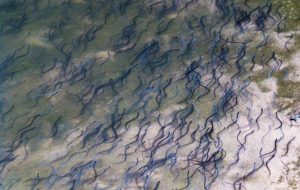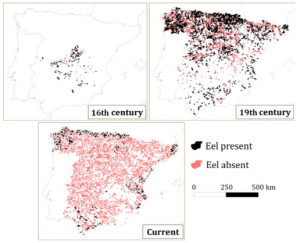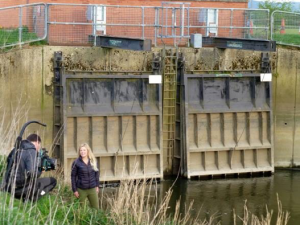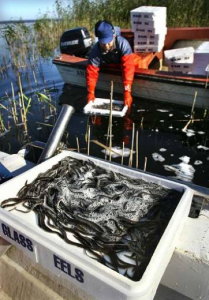DOWNLOAD SEG 2020. Position on Restocking
Introduction
In 2007, the EU Eel Regulation (EC 1100/2007) was adopted, aiming to protect and restore the stock of the European eel Anguilla anguilla (L.). Article 7 of that Regulation discusses restocking, that is the translocation of young eels. In the years after the adoption of the Regulation, the restocking paragraphs have been much discussed, and views have polarised considerably.
In this text, SEG presents some background to this controversial issue, and formulates its position on restocking as it relates to responsible and sustainable management. We do not discuss cost-effectiveness, assignment of responsibilities, and implementation details.
What is restocking?
The European eel is most abundant along the coast, particularly in the area around the Bay of Biscay. Up rivers, as well as further north and east on the continent, the eel stock is far less abundant. Historically, eel occurred all over Scandinavia, far into Russia, the whole Mediterranean, far up into the mountains – everywhere.
But over the centuries, river barriers and water pollution increasingly depleted those stocks, and nowadays, eel is much less abundant the further one goes away from the coast. In the mid-1800s, the idea popped up to ‘seed the waters’ by releasing young fish into degraded or inaccessible habitats, far inland. For fish besides eels, they were produced in newly designed ‘fish factories’ (hatcheries). But eel couldn’t be reproduced that way, and in 2020 we still haven’t been able to do that.

Migrating juvenile eels
Instead, a practice was developed to transport young eel (glass eel) from areas of highest abundance to supplement lower populations elsewhere. When they realised that these relocated eels would not reproduce locally, it became important to transport high numbers, on a repeated basis, which made it a costly operation. Today, the transport of eel from the river mouth to lakes and streams within the same drainage area is often called “assisted migration”, while cross-drainage transports are indicated as “restocking”.
Here, we primarily discuss restocking, but most of this also applies to assisted migration.
Where, when and how much has restocking been practiced?
The very first restocking took place in France, in 1840. In the decades following, the practice gradually spread all over Europe, translocating increasing volumes of glass eel. The biggest increase took place just after World War II. In the peak years (1970s), about 150 million glass eels (of the 6,000 million caught in France at that time) were distributed annually throughout Northern Europe, with an estimated yield of over 5,000 tonnes of fully-grown eel (compared to 20,000 tonnes from fisheries from the naturally recruited eel at that time).

German eel station at Epney, River Severn, UK, 1908
After 1980, restocking numbers fell dramatically, to only 2.5 million in 2009. Since the adoption of the European Eel Regulation (2007), restocking has increased again, to more than 30 million per year, with an estimated production of about 1,000 tonnes of silver eel (this increase occurred since 2010, i.e. peak production is expected from roughly 2020 onwards, as the average silver eel is at least 10 years old).
Further details on the history of eel restocking can be found in Dekker and Beaulaton (2016).
Why is restocking controversial?
Glass eel restocking has always been controversial. In the mid-1800s, nobody believed that you could keep young fish alive over long distances in a stage coach – but the glass eel did survive.
Later it was objected that in their new habitat they would not be able to find food, not be able to grow, to mature into silver eels, to find their way back to the sea, to know in which direction the Sargasso lies. But so far all of this has turned out to be untrue: the restocked eel more or less behaves identically to their naturally recruited fellows.
Actually, there is now only one question left open: ‘Will they reach the Sargasso Sea, and will they successfully contribute to the reproduction there?’ The answer is simple and short: we don’t know, and there’s no real chance of finding out in the foreseeable future – we don’t know enough about the Sargasso and the reproduction even for unstocked eel.
Uncertainty, and we will have to live with that for now.
Is restocking recommendable, permissible, or condemnable?
Uncertainty, and we’ll have to live with that. So, can everyone fill in their own preferences here and come up with a controversial answer? Well, no: in the 1990s, political agreements were made all over the world on how to deal with uncertainties. These agreements became known as the Precautionary Approach. As the name suggests, caution is paramount: in case of doubt, do not take immediate risks, but think again. And the Precautionary Approach provides guidelines for that.
This doesn’t mean that glass eel restocking should be avoided at all costs, but that the risks should be faced, calculated if possible (but for eel, we cannot), and ultimately taken into account in political decision-making. To our regret, scientific advice by the International Council for the Exploration of the Sea (ICES) has been rather unclear on this point in recent years, and has swung back and forth between principled purism and pragmatic acceptance of political decisions.
The Precautionary Approach, in our view, provides very clear guidelines for an almost identical case: the release of artificially reproduced juvenile fish. Artificial reproduction (in the laboratory) is not quite the same as glass eel restocking (caught in the wild), but the risks of artificial reproduction are in principle greater than those of glass eel stocking. If we apply the guidelines on artificial reproduction to restocking practices too, we stay on the safe side.
For artificial reproduction, the FAO Technical Guidelines for Responsible Fisheries (1996, point 48.g) states unequivocally: ‘Do not use artificial reproduction as a substitute for precautionary measures’. That is quite explicit, and the meaning for our discussion is also clear: there is no fundamental objection against glass eel restocking, as long as it does not replace the necessary protection, and it is not considered to compensate for overfishing or migration problems.
Since 2017, ICES has fortunately taken a firmer stance, not far from this: ‘[restocking] should not be used as an alternative to reducing anthropogenic mortality’. Let’s keep that position.
What is the purpose of restocking?
Restocking has been applied for a number of different purposes, and even today a wide range of aims is served. Historically, the main driver has been commercial profit: to increase the yield from an existing fishery (or to establish a new fishery). Most often, however, that fishery was in decline for quite some time, before the restocking started – due to migration barriers, habitat loss and water pollution. So, the restocking effectively compensated the fishery for those impacts.

Eel distribution in Spain. From Clavero & Hermoso 2015
In recent decades, it has been argued that there is a surplus of glass eel on the market, which would otherwise have been used for direct human consumption.
Restocking this surplus benefits the fishery, but also increases silver eel escapement. Additionally, it has been argued that the habitat loss in the rivers and wetlands of the ‘glass eel countries’ has created a shortage of available habitat – that is: has created a surplus of glass eel that could not survive in their ‘home river’ anymore.
Further, it has been argued that restocking actually increases the spawner production; that restocking might create a better net survival than the wild stock; that without restocking, there would be hardly any eel left anymore in many (upstream) habitats; and many more lines of thought.
Obviously, the situation is complex, and many different views exist. We will have to deal with that.
How does SEG look upon restocking?
Restocking has become a controversial practice, in which many parties in most countries are involved. Because of the complexity of the issue and the polarised opinions, we will not attempt to evaluate all arguments for and against for each and every situation. Instead, we highlight the criteria that are important, whatever the situation.
First, it will be important to source restocking from areas that have responsible and sustainable eel management. In particular, the presence of major migration barriers and habitat loss should not be used as a lasting excuse to harvest the congesting glass eel below barriers.

There are 1.3 Million barriers to eel migration in Europe
Secondly, the release of restocking into a destination area should not be used as a compensation for other man-made impacts, and the restocking should not negatively affect the naturally recruited eel.
And thirdly, given the current low abundance of the eel, the harvesting, transport and release should be done in a responsible way, causing a minimum of handling mortality.
Obviously, biosecurity measures must be applied to ensure that alien species and disease are not spread during restocking.
In today’s practice, many restocking programmes are closely linked to commercial exploitation, often in the form of the fishing sector (co)-financing or organising. As long as the three conditions discussed above are respected, SEG sees no problem with that.
Or even, we welcome the involvement of the sector in implementing responsible management and welcome the investment in measures to increase the stock despite the inherent uncertainties that restocking has.
Having said so, how does SEG look upon the transfer of glass eel from fully blocked rivers in south-western Europe where very little habitat remains freely accessible, to blocked rivers in north-western and central Europe where today very little natural recruits can come in?

Restocking in Sweden
